
Lyme Regis is a town in west Dorset, England, 25 miles (40 km) west of Dorchester and east of Exeter. Sometimes dubbed the "Pearl of Dorset", it lies by the English Channel at the Dorset–Devon border. It has noted fossils in cliffs and beaches on the Heritage or Jurassic Coast, a World Heritage Site. The harbour wall, known as The Cobb, appears in Jane Austen's novel Persuasion, the John Fowles novel The French Lieutenant's Woman and the 1981 film of that name, partly shot in the town. A former mayor and MP was Admiral Sir George Somers, who founded the English colonial settlement of Somers Isles, now Bermuda, where Lyme Regis is twinned with St George's. In July 2015, Lyme Regis joined Jamestown, Virginia in a Historic Atlantic Triangle with St George's. The 2011 Census gave the urban area a population of 4,712, estimated at 4,805 in 2019.
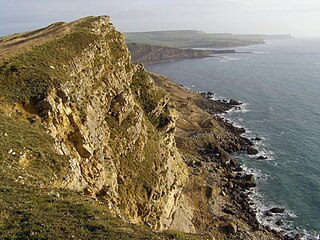
The Jurassic Coast is a World Heritage Site on the English Channel coast of southern England. It stretches from Exmouth in East Devon to Studland Bay in Dorset, a distance of about 96 miles (154 km), and was inscribed on the World Heritage List in mid-December 2001.

Kimmeridge is a small village and civil parish on the Isle of Purbeck, a peninsula on the English Channel coast in Dorset, England. It is situated about 4.5 miles (7.2 km) south of Wareham and 7 miles (11 km) west of Swanage. In 2013 the estimated population of the civil parish was 90.
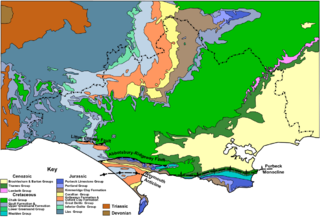
Dorset is a county in South West England on the English Channel coast. Covering an area of 2,653 square kilometres (1,024 sq mi); it borders Devon to the west, Somerset to the north-west, Wiltshire to the north-east, and Hampshire to the east. The great variation in its landscape owes much to the underlying geology, which includes an almost unbroken sequence of rocks from 200 to 40 million years ago (Mya) and superficial deposits from 2 Mya to the present. In general, the oldest rocks appear in the far west of the county, with the most recent (Eocene) in the far east. Jurassic rocks also underlie the Blackmore Vale and comprise much of the coastal cliff in the west and south of the county; although younger Cretaceous rocks crown some of the highpoints in the west, they are mainly to be found in the centre and east of the county.
The Early Jurassic Epoch is the earliest of three epochs of the Jurassic Period. The Early Jurassic starts immediately after the Triassic-Jurassic extinction event, 201.3 Ma, and ends at the start of the Middle Jurassic 174.1 Ma.

Ringstead Bay, with the small village of Ringstead at the eastern end and the prominent headland of White Nothe at the western end, is located on the coast in Dorset, southern England. The area lies on the Jurassic Coast and is known for its natural environment and fossils.
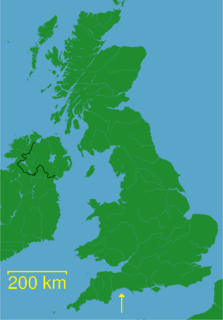
Lyme Bay is an area of the English Channel off the south coast of England, situated between Start Point in the west and Portland Bill in the east. The south western counties of Devon and Dorset front onto the bay.

Seatown is a coastal hamlet in Dorset, England, sited on the English Channel approximately 3 miles (4.8 km) west-southwest of Bridport. It lies within the civil parish of Chideock.

The Purbeck Group is an Upper Jurassic to Lower Cretaceous lithostratigraphic group in south-east England. The name is derived from the district known as the Isle of Purbeck in Dorset where the strata are exposed in the cliffs west of Swanage.

Ringstead is a small village located on the coast in Dorset, southern England. The area lies on the Jurassic Coast and is known for its natural environment and fossils. Ringstead Bay and White Nothe are to the east. Bran Point and Osmington Mills are to the west.
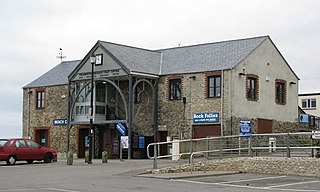
The Charmouth Heritage Coast Centre is based in the upstairs floor of a long-disused cement factory on the foreshore of Charmouth in Dorset, England.

Durlston Bay is a small bay next to a country park of the same name, just south of the resort of Swanage, on the Isle of Purbeck in Dorset, England. It has been a renowned site for Lower Cretaceous fossils since the initial discovery of fragments there by Samuel Beckles in the 1850s.

Arietites is a genus of massive, giant evolute, psiloceratacean ammonites in the family Arietitidae in which whorls are subquadrate and transversely ribbed and low keels in triplicate, separated by a pair of longitudinal grooves, run along the venter. Fossils are known world wide from the lower Sinemurian stage of the Lower Jurassic. Safari Ltd made an Arietites bucklandi figurine in 2014.
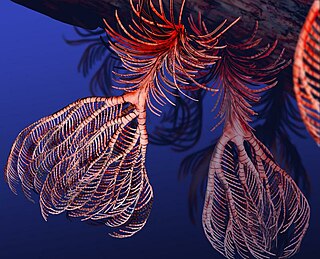
Pentacrinites is an extinct genus of crinoids that lived from the Hettangian to the Bathonian of Asia, Europe, North America, and New Zealand. Their stems are pentagonal to star-shaped in cross-section and are the most commonly preserved parts. Pentacrinites are commonly found in the Pentacrinites Bed of the Early Jurassic of Lyme Regis, Dorset, England. Pentacrinites can be recognized by the extensions all around the stem, which are long, unbranching, and of increasing length further down, the very small cup and 5 long freely branching arms.

Kimmeridge Bay is a bay on the Isle of Purbeck, a peninsula on the English Channel coast in Dorset, England, close to and southeast of the village of Kimmeridge, on the Smedmore Estate. The area is renowned for its fossils, with The Etches Collection in the village of Kimmeridge displaying fossils found by Steve Etches in the area over a 30-year period. It is a popular place to access the coast for tourists. To the east are the Kimmeridge Ledges, where fossils can be found in the flat clay beds.

Worbarrow Tout is a promontory at the eastern end of Worbarrow Bay on Isle of Purbeck in Dorset on the south coast of England, about 6 kilometres (3.7 mi) south of Wareham and about 16 kilometres (10 mi) west of Swanage. Immediately to its east is Pondfield Cove.
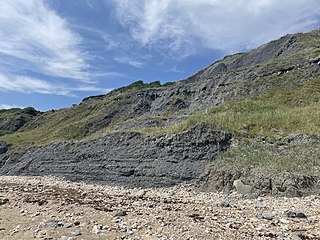
Black Ven is a cliff in Dorset, England between the towns of Charmouth and Lyme Regis. The cliffs reach a height of 130 metres (430 ft). It is part of the Jurassic Coast World Heritage Site. Nearby is an undercliff with an ammonite pavement. The area is popular with tourists due to a number of fossils being found in the area.

Dinosaurland Fossil Museum is a privately owned fossil museum in Lyme Regis, on the Jurassic Coast in Dorset, England. The museum is located in a historic Grade I listed former congregational church building.

Portland Raised Beach refers to small raised beaches on each side of Portland Bill, on the Isle of Portland, part of the Jurassic Coast in Dorset, England. The main one is known as the West Pleistocene Raised Beach; nearby is the East Pleistocene Raised Beach.
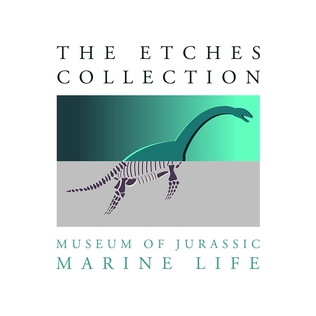
The Etches Collection is an independent fossil museum located in the village of Kimmeridge, Purbeck, Dorset, England. It is based on the lifetime collection of Steve Etches, a fossil hunter for whom some of his finds have been named, from the local area on the Jurassic Coast, an SSI and World Heritage Site, especially around Kimmeridge Bay and the Kimmeridge Ledges.



















